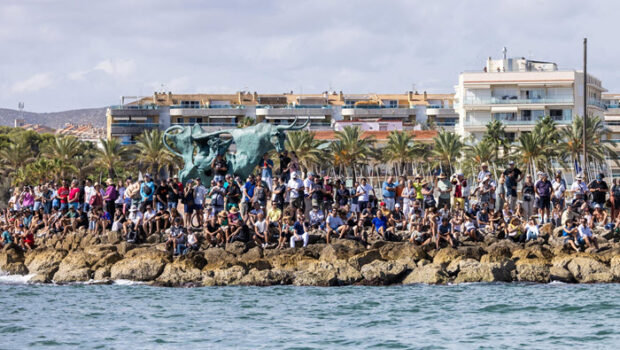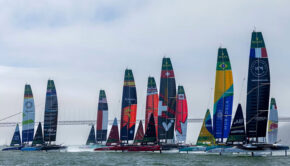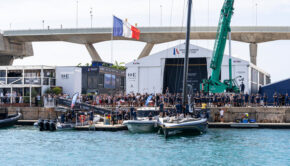Sorry, this is now going too far
Published on September 18th, 2023
by Craig Leweck, Scuttlebutt Sailing News
During the America’s Cup era when Larry Ellison controlled the event, the mission was to create a spectator sport that would attract commercial riches. He gave it his best shot in 2013 and 2017, but restrictions within the event proved challenging, so he birthed the SailGP League to better execute the vision.
But the new holders of the America’s Cup are again trying to shape the event into an entertainment product, and as both events use foiling boats that have limits in light and strong winds, when combined with the time constraints due to live and broadcast spectating, the show doesn’t always go on.
That was the case at the first Preliminary Regatta for the 37th America’s Cup, and when I asked whether the AC40 racing provided a good show to watch, here was the feedback I received:
Matt Wilkinson; Sydney, Australia:
I find the foiling ‘boats’ used in SailGP and America’s Cup a complete irrelevance as far as sailing is concerned. Sure, they are a bit of a spectacle (especially for people who know nothing about sailing) but for sailors who appreciate the subtleties and skills of racing, they are a bizarre sideshow.
Matt Tobriner:
The technology of foil design, onboard power generation, and computer/sensor driven system management is quite interesting to hydro-dynamists, electrical engineers, and automation experts, but not so much to displacement hull racers and cruisers. When changing from upwind to downwind sailing angles means easing the main sheet a few inches in lieu of setting a chute, there seems to be a bit of action missing.
With the Sword of Damocles hanging below one’s feet (i.e., the threat of falling off foil), there results a necessary preference for high-speed non-engagement. All of this diminishes the spectacle of the sport and the ability of the audience to learn. Sorry that I have no solution—just these observations.
Bill Canfield:
Something is wrong with the America’s Cup concept when the most exciting part of the race is when they fall off the foils. What did we learn from the first America’s Cup event?
1.Sailing can be boring to watch, but when you add light wind foiling to the mix, it gets really boring.
2. In light air, being behind is advantageous.
3. When you can only see two heads, it looks more like model boat racing than a real event.
4. When the action is stopped for lack of breeze, you probably should not show live exciting action from past events in 12s and 70 footers. It is confusing to the non-sailor and they may question the wisdom of moving to foiling boats that feature just heads.
5. What does spending millions of dollars on just the tips of foils really achieve unless conditions are perfect which seldomly occurs.
6. How and why would one take the world’s most premier and historical sporting event and throw away the positives, traditions, and all things that once contributed to its heritage and historic value?
7. In 1987 Fremantle, three million viewers got up in the middle of the night to watch the action. We can safely say that will not happen again with these non-sailing hulls.
8. SailGP has a much better product than the America’s Cup and they continuously make their events better with innovating ideas.
Mark Harris:
I have been sailing for 65 years now, and grown up and participated with and in some of the major big boat races and sailors around the world. I have also watched on as the sailors with much better natural sailing skills than I could imagine, have skillfully steered these magnificent yachts around a race course.
The rules of the America’s Cup back in the twentieth century were fabulous. Hard fought tactical, long, and tough races decided which two boats designed to a specific rule would then face off for the chance to win the legendary America’s Cup, not just for themselves, but for their Country. And the promotion of this event had even the non-sailors in a country interested enough to watch and listen to “their” guy’s competing.
There was footage of wind-swept young men scampering around a heaving deck, winches turned by people whose arms rotated so fast it seemed they were going to fall off. As the boats changed direction, we could see a flurry of activity as sails were manually trimmed and adjusted, or changed and raised and lowered, all by the wind-swept guys we saw earlier.
The skippers would bark orders on instructions received from the tactician/navigator, and sometimes to ensure the other boat could not pass, the same wind-swept men who have done so much already would be required to change course 20 or 30 times in a single 20 or 30 minute leg of the course.
Real sailing, in real boats by real hardworking wind-swept men, who had been funded by an entrepreneur, for their own self-esteem, sure, but also for the pride of winning for their country.
America’s Cup rules today bear absolutely no resemblance to sailing that the average person can relate to. The boats, (a loose description, because I cannot be sure that they can be called boats), look ridiculous in my humble opinion, and although the promo’s promise exciting high-speed action, so far nothing much has happened.
A small crew of helmeted commuter operators and some cyclists or strongmen perform whatever tasks are required, (can’t say because we never see the tasks) while a tactician/navigator with a computer degree tells the skipper what to do. And another crewman has the job of looking at a computer and pushing buttons to trim the sails. (Again a loose description, as in my book the main sail is about as far removed from a sail as can be).
Sorry, this is now going too far.
In short, bring back real sailing boats, with real hardworking men sailing them around long courses, with real sails and representing their Country and which give the viewing public, (not just the corporates) some semblance of understanding of the sport of sailing, and the history of the “Cup”.
Peter Brown:
I watched (some) of this on YouTube, and all I can say is that the Kiwi defender has made a terrible, terrible mistake. These may as well have been radio-control boats on the course. Having four ‘sailors’ hunkered down in the hulls like soldiers in a pillbox running steering wheels and joysticks is dull, dull, dull.
Those who want to debate whether this is sailing at all can do so – but as far as a spectator sport, it’s probably more exciting watching people play Call of Duty on Discord. Take away the wind, and it was just pathetic. American Magic may have won, but the America’s Cup is the real loser.
Following the publication of the AC37 Protocol and AC75 Class Rule on November 17, 2021, the AC75 Class Rule and AC Technical Regulations were finalized on March 17, 2022. The entry period opened December 1, 2021 and runs until July 31, 2022, but late entries for the 37th America’s Cup may be accepted until May 31, 2023. The Defender was to announce the Match Venue on September 17, 2021 but postponed the venue reveal, confirming it would be Barcelona on March 30, 2022. The 37th America’s Cup begins October 12, 2024.
Teams revealed to challenge defender Emirates Team New Zealand (NZL):
• INEOS Britannia (GBR)
• Alinghi Red Bull Racing (SUI)
• Luna Rossa Prada Pirelli Team (ITA)
• NYYC American Magic (USA)
• Orient Express Racing Team (FRA)
2023-24 Preliminary Regattas
September 14-17, 2023 (AC40): Vilanova i la Geltrú, Spain
November 30-December 3 (AC40): Jeddah, Saudi Arabia
August 2024 (AC75): Barcelona, Spain
2024 America’s Cup
September: Challenger Selection Series
October 12 – ?: 37th Match (Best of 13)
Additionally, 12 teams will compete in the 2024 Youth & Women’s America’s Cup.
Noticeboard: https://ac37noticeboard.acofficials.org/
Additional details: www.americascup.com/en/home









 We’ll keep your information safe.
We’ll keep your information safe.